Why I do this comparison
Everybody is searching for image quality. Everybody wants to have the best possible image technically. But the better sensor is the bigger - due to many reasons. And one of those reasons comes from the physics: Camera sensors are photon counters.. And if one pixel is larger there are more photons to count... and as more photons are counted the distance to zero becomes larger. And as larger this level is as more informations an image can get. Very simple spoken.
But larger sensors have their drawbacks, too. And one of these drawback is the camera size. Camera size means weight to carry and bag size as well. But not only the camera became larger, the lenses too. A µ43-Equipment fits in each pocket... very simple. A full format camera will need a bag...
My question is: What will I loose when I carry the in little µ43-cameras with me instead of the FullFormat Monsters... So i decided to investigate the commons and the differences.
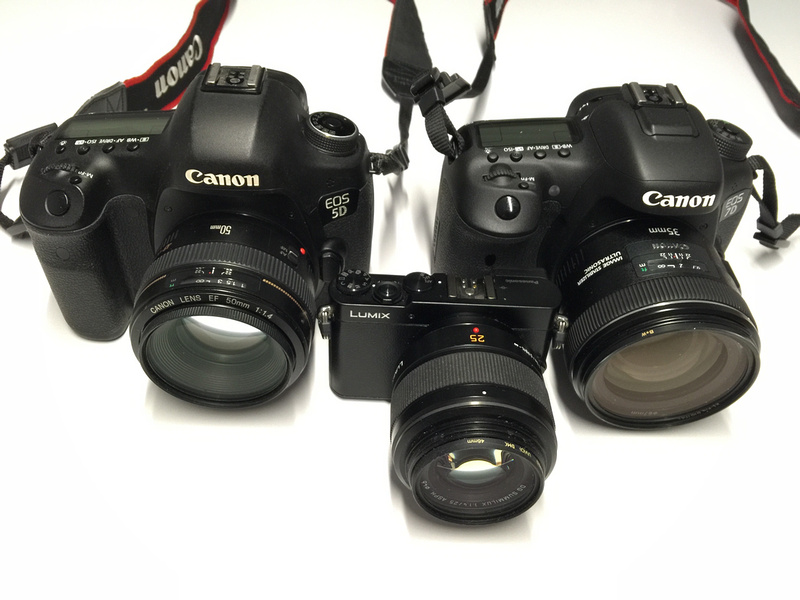

The basics behind the investigations
When I started writing my blog I compared the bokeh between full format and µ43 at the same settings: http://delightphoto.zenfolio.com/blog/2013/7/fullformat-vs-43-comparison-of-bokeh Here you could see that the depth of field is the clear differentiator...
Basically the comparison is characterized by the so called crop factor: This is the factor you have to multiply the actual focal length to get the full format equivalence.
-
50mm @ Full Format: Crop 1: 50mm@Fullformat
-
35mm @ APS-C Format: Crop 1.6: 56mm@Fullformat
-
25mm @ µ43: Crop 2: 50mm@Fullformat
But this is only half of the truth. The other factor to be considered is the depth of field. This is following the same factor. If I want to get comparable images I do have to multiply the aperture with the crop factor as well:
-
f1.4 @ µ43: Crop 2: f2.8@Fullformat
-
f2.0 @ APS-C Format: Crop 1.6: f3.2@Fullformat
-
f2.8 @ Full Format: Crop 1: f2.8@Fullformat
If I want to get the same impression of a photo in terms of depth of field I will have to compare at comparable levels but in this case I will have to vary the ISO or the shutter speed:
|
|
f |
t |
ISO |
|
FF |
2,8 |
1/25 |
400 |
|
APS-C |
2.0 |
1/50 |
400 |
|
µ43 |
1.4 |
1/100 |
400 |
When I look to the sensor performance data there should be a clear difference between the different cameras...
I follow here the systematic of DXO in Paris who perform comparisons of lenses and camera sensors in a very detailed way, based on scientific measurements:
http://www.dxomark.com/Lenses/Compare/Side-by-side/Canon-EF-35mm-F2-IS-USM-on-Canon-EOS-70D-versus-Panasonic-Leica-Summilux-DG-25mm-F14-on-Panasonic-Lumix-DMC-GM1-versus-EF50-mm-f-1.4-USM-on-Canon-EOS-5D-Mark-III___1086_895_450_920_196_795
But numbers are not everything...
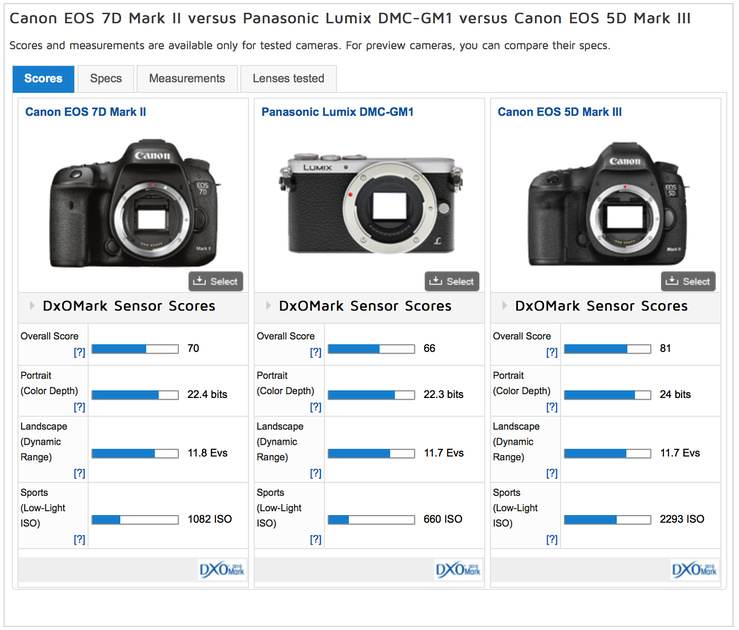

Evaluating the figures above you see: the sensor score between APS-C and µ43 is pretty close and the difference to FF quite big. The biggest impact you will see in the low light performance but in portrait and and especially landscape the dynamic range looks pretty much the same....
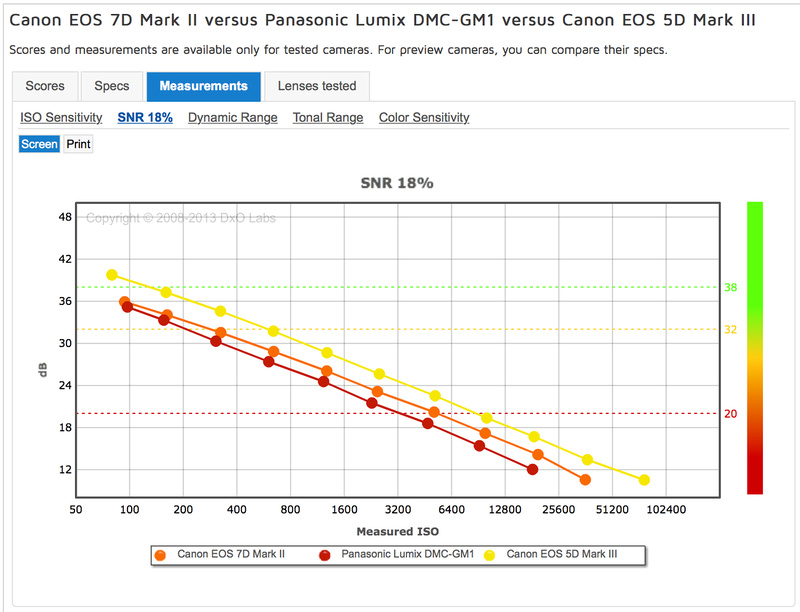

This graph shows signal to noise: A clear winner is the 5D2...
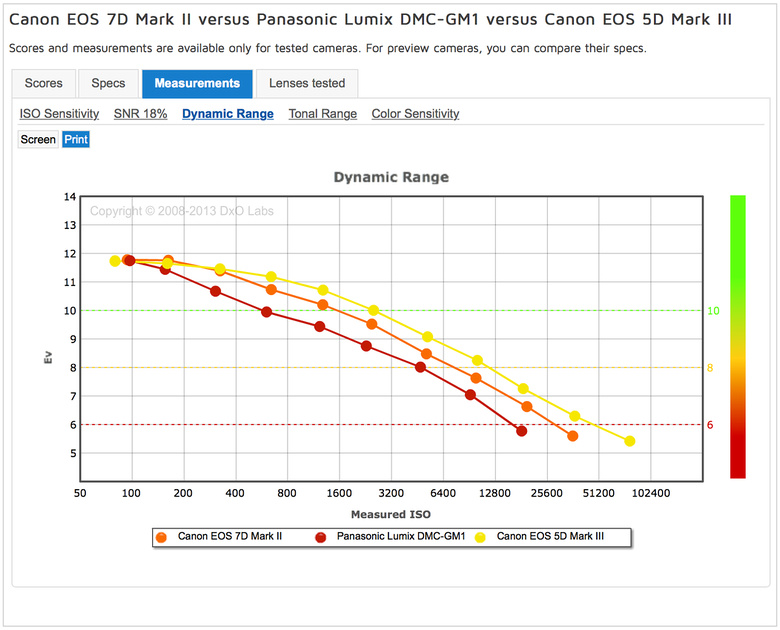

For the Dynamic range At low ISO-Values: all 3 cameras behave similar... The differentiation comes with the higher ISO´s.
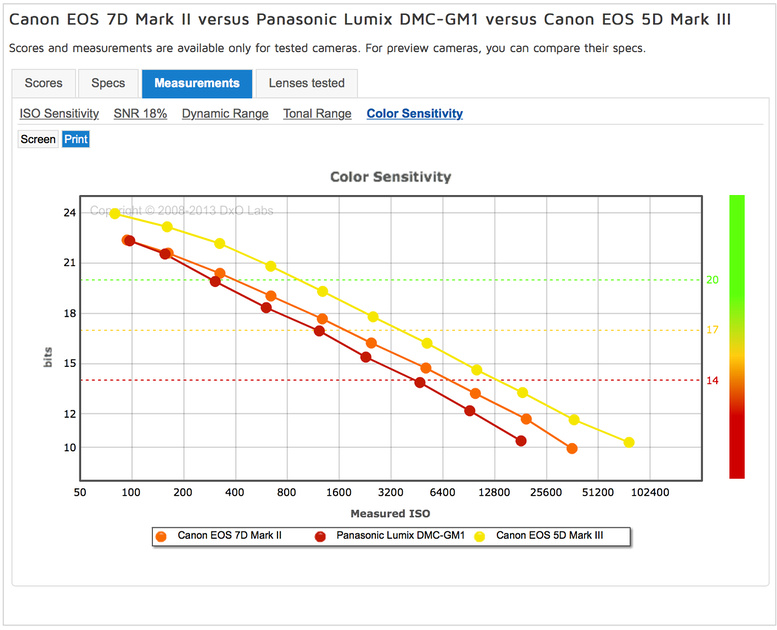

The color sensitivity shows a similar behavior for all cameras: a clear winner and to followers which are pretty close.
Testequipment
For the test shoots I have chosen the following set up:
-
Full Format: Canon EOS 5DMkIII with the Canon EF 1.4/50mm USM
-
APS-C: Canon EOS 7DMkII with the EF 2.0/35mm IS/USM
-
µ43: Panasonic Lumix GM1 with the Leica Summilux 1.4/25mm
All lenses are excellent, good performers...
Also here are the performance datas available.
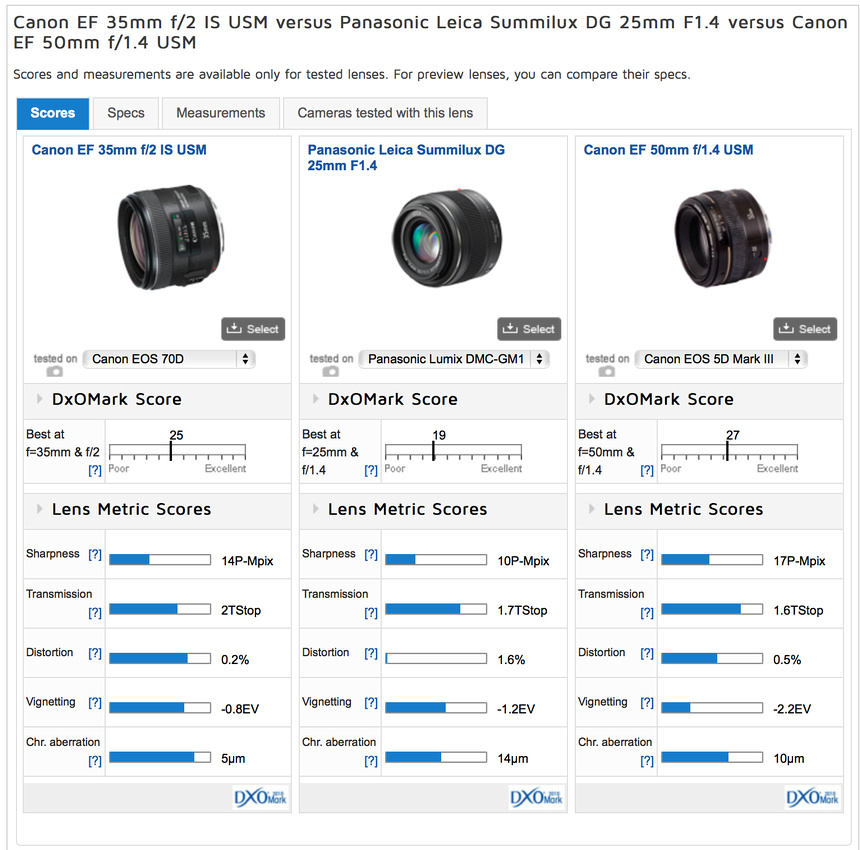

These are the scores of the used lenses with the used sensors,
The 7DMkII uses the same sensor like the 70D, therefore I chose the 70D data for the comparison. As a conclusion: there should be a big difference in sharpness and chromatic aberrations...


The difference in sharpness should be manifested in the outer regions -according to the figure above. The field map shows the used setup of the lenses: µ43 wide open, APS-C wide open and the FF @ 2.8.
Image Workflow:
-
All images were captured in RAW.
-
Iff possible there was a white balance adjustment on similar points in the image
-
The Images were loaded in aperture.
-
From Aperture the photos were converted into TIFF and opened in photoshop. (Automatic Handling)
-
In Photoshop the images were combined to one image by copy and paste
-
From Photoshop the images were exported as TIFF-Files
No further adjustments were done.
Real Images
But what does real images will show us???
All images are in the same order: The top shows the Full Format, In the middle You see APS-C and the bottom shows the µ43 image
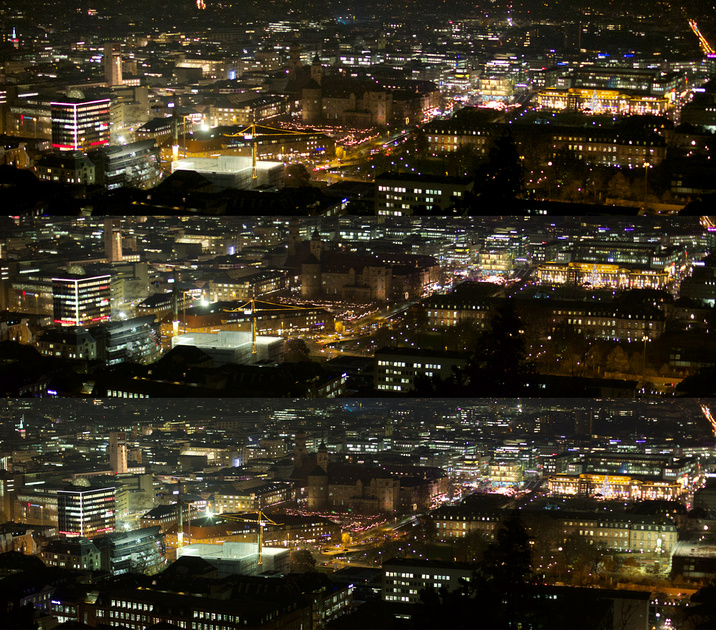

Handheld Nightshots, ISO 1600, wide open and 1/25s; 1/50s 1/100s
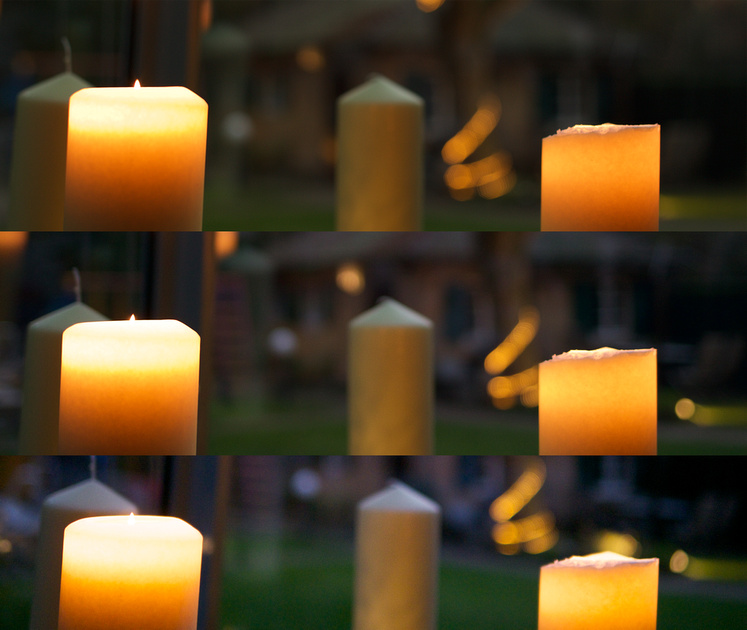

Handheld, ISO 400, wide open and 1/25s; 1/50s 1/100s
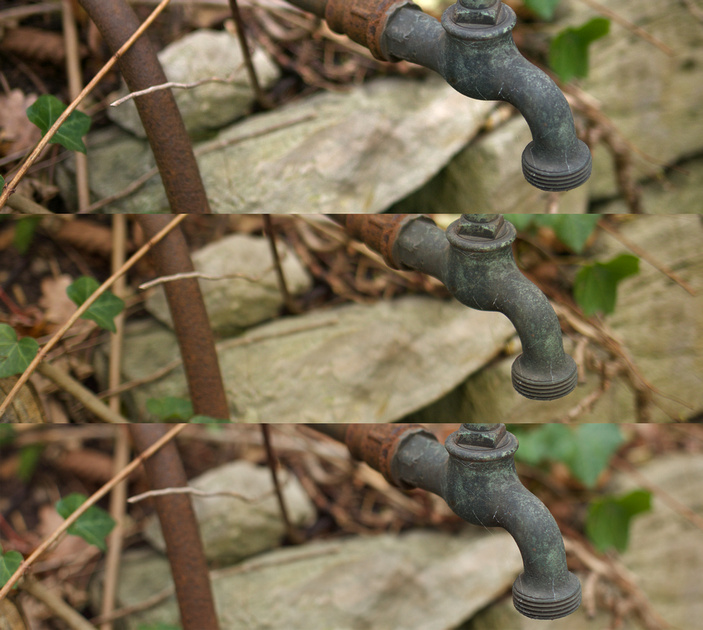

Handheld, ISO 200, wide open and 1/200s; 1/400s 1/800s
Do you see major differences? I cannot see it... Why not to choose µ43 generally? Yes, there are differences... and some can come out pretty ugly:
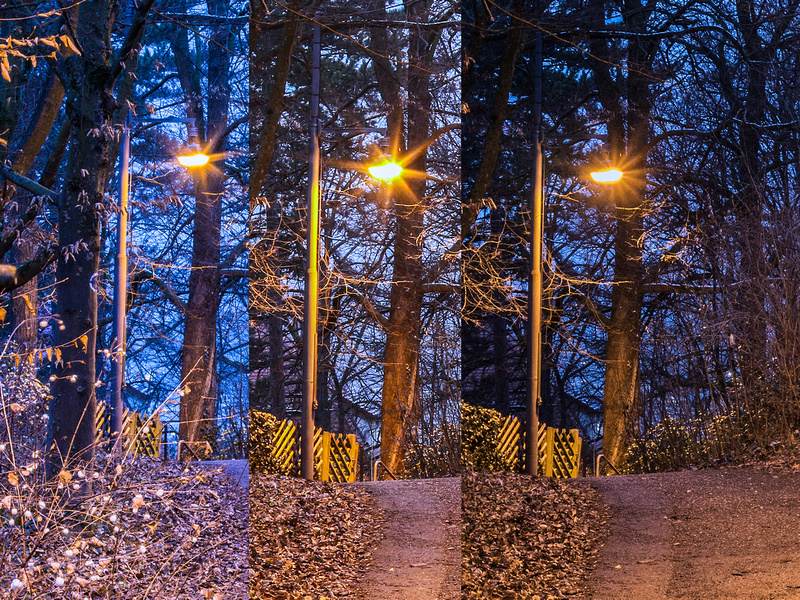

Shot on a tripod, FF/APS-C/µ43 with ISO 400 and f16/f11/f8.... What you see is some refraction patterns at the end of the rays. This is really improved against the first generation of µ43 cameras. What I mean: please look at the image below.
But what you can see as well: there is much more contrast much more information in the left image than in both images right of it - but they are close together...
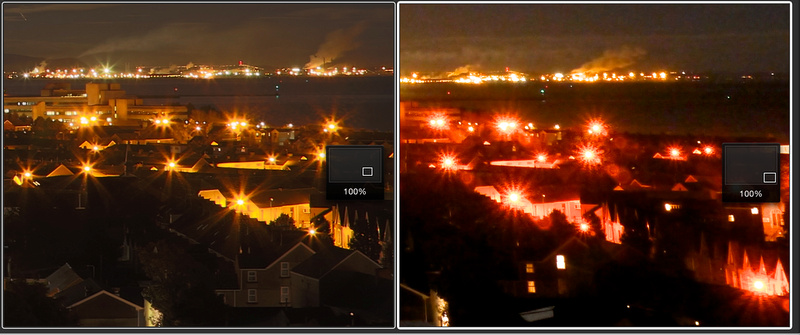

These photos were shot as JPG at a time i did not shoot RAW, somewhere in 2011. The left image was shot with the 5DMkII and the 28-300mmL from Canon while the right image was shot with a G% and the 14-140mm Mk1 from Panasonic.
Conclusio - if there is one..
First of all: in terms of measurements there are big differences between the different cameras and sensor formats. I will add some more images in the future to differentiate the cameras and sensor sizes.
-
For a general use: µ43 gives you a great performance, especially if you take into account size and weight you want to carry...
-
The APS-C format is something which is no fish no meat. It is somewhere in between. It is more on the µ43 side than on the full format.
-
The Full Format gives you the best image quality - but you will get aware of it only under extreme conditions. But under these conditions the benefit will be great...
But this is only have of the truth. We can not compare sensors. We will have to compare lenses and cameras as well. And here comes some bigger differentiators. Handling, build in features speed etc. Just looking at image quality Full Format and m43 would be enough. But for me APS-C comes with the 7D´s. And the 7D´s are really great cameras: Very fast with a great autofocus. I never used my µ43 cameras for sports. I do not have the confidence in the autofocus and the level of control I have shooting with the DSLR´s...
What camera I recommend?
-
7DMkII: Without doubt: the best camera I know for sports and wildlife. No compromise on speed and accuracy
-
5DMkIII: The best low light performer. If you know that you will have to shoot in the dark: The best I know.. (Or generally spoken: take Full Format. I know that Sony´s A7s is even better in low light). And a very good studio camera as well... And you can use it for sports and wildlife, too...
-
µ43: You want to have the image quality of a standard DSLR but you do not want to carry it: Here is your solution. For I would say 90% of the "normal"photographic stuff µ43 is more than enough. And they are very well equipped with tons of features like remote control from iPhone or iPad, build in time lapse etc... The µ43s are the solution if you want to make great images everywhere at anytime and nobody should realize that you are carrying a great camera with you.